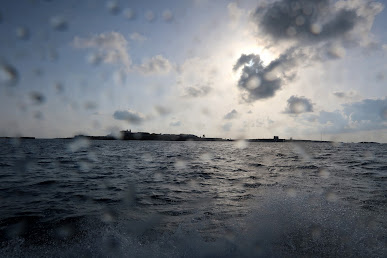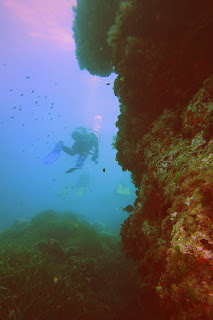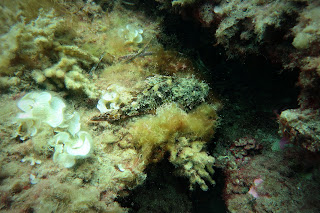Tabarca is an islet near Alicante on the Costa Blanca and is easily reachable from Santa Pola. As it's been more than 6 months since I arrived in Spain, I was unable to rent a car with my UK licence (thanks Brexit) I therefore took the train down to Alicante from Valencia then the bus to Santa Pola.
There are permanent inhabitats living on Tabarca all year round with numbers increasing significantly during the summer when tourism becomes the main economic activity. It became a protected marine reserve in 1986 making it a very popular dive site.
Journey towards Tabarca
Dive 1: Islote de La Nao (#7 on map)
Met at the dive centre at 7:30 instead of 8:30 due to deterioration of weather forecast. It turned out to be very choppy. Lots of people getting seasick. I had planned to dive the next day at Tabarca but diving was cancelled and I decided against doing the shore dives at Cartagena.
Juvenile damselfish, Chromis chromis
The brilliant blue colour of the juvenile damselfish, Chromis chromis, is common to rocky reefs ranging in depths from 3 to 35 m in the Mediterranean Sea. It has been suggested that C. chromis is the most abundant fish species in the ecosystem and always ranked either number 1 or 2 in terms of most abundant species (Pinnegar, J.K.). It is a major prey item for larger fish and birds.
C. chromis feed in huge shoals and rest close to the seabed at night. It consumes zooplankton and is a major consumer of fish eggs. Shoals of adult damselfish fish can be seen here during a dive I did in Almeria.
The brilliant blue colour of the juvenile damselfish, Chromis chromis, is common to rocky reefs ranging in depths from 3 to 35 m in the Mediterranean Sea. It has been suggested that C. chromis is the most abundant fish species in the ecosystem and always ranked either number 1 or 2 in terms of most abundant species (Pinnegar, J.K.). It is a major prey item for larger fish and birds.
C. chromis feed in huge shoals and rest close to the seabed at night. It consumes zooplankton and is a major consumer of fish eggs. Shoals of adult damselfish fish can be seen here during a dive I did in Almeria.



















